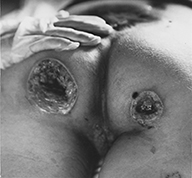Hesperian Health Guides
Chapter 24: Pressure Sores
Contents
What are they?
Pressure sores, or ‘bed sores’, are sores that form over bony parts of the body when a person lies or sits on that part of the body for too long without moving. Where the skin is pressed against the bed or chair, the blood vessels are squeezed shut so that the blood cannot bring air to the skin and flesh. If too much time passes without moving or rolling over, the skin and flesh in that spot can be injured or die. First a red or dark patch appears. And if the pressure continues, an open sore can form. The sore may start on the skin and work in. Or it may start in deep near the bone and gradually work its way to the surface.

Who is likely to get pressure sores?
When a healthy person lies or sits in one position for a long time, it begins to feel uncomfortable, or to hurt. So she moves or rolls over, and pressure sores are avoided. People most likely to get pressure sores are:
| 1. persons cannot roll over by themselves due to illness, injury, or disability. This includes people with brain injury, advanced muscular dystrophy, and paralysis. |
|
2. persons who have no feeling in parts of their body, who do not feel the warnings of pain or discomfort when their body is being injured. This includes persons with spinal cord injury, spina bifida, and leprosy. |
|
WARNING! Because persons with spinal cord injury are at first unable to turn over, and also have lost the ability to feel in parts of their bodies, they are at very high risk for pressure sores. |
|
3. persons who have a plaster cast on an arm or leg (to correct a contracture or to heal a broken bone), when the plaster presses over a bony spot. At first the pressure will hurt and the child may cry or complain. But in time the spot will grow numb and the child will stop complaining—although a sore may be forming. The risk is greater when using casts on children who have no feeling in their feet. On these children, even a corrective shoe or brace can easily cause a pressure sore—unless great care is taken. |
Where are pressure sores most likely to form?

They can form over any bony area. The places where they form most often are shown in the pictures.
The points of highest risk, all on the hips, are marked in CAPITAL LETTERS.
 inner ankle bones and base of big toe (sores caused by casts or footwear
front of knee
crest of hip
TOP OF THIGH BONE (side of hip)
outside of knee and top of lower leg bone
outer ankle bone | |
 back of head
shoulder blades
shoulder
elbow
inside of knees
TAIL BONE (BASE OF SPINE)
BOTTOM CURVES OF HIP BONE (from sitting)
back of heel |
How dangerous are they?

 |
| These pressure sores in a 15-year-old girl with quadriplegia were treated with honey and sugar and healed in 2 months. PROJIMO |
Pressure sores, if not very carefully cared for, can become large and deep. Because they contain dead skin and flesh, they easily become infected. If a sore reaches the bone, which it often does, the bone can also become infected. Bone infections are often very hard (and costly) to cure, may last for years, and may keep coming back, even after the original pressure sore has healed (see “Bone Infections,” Chapter 19). Bone infections can lead to severe disabling deformities.
Infections in deep pressure sores often get into the blood and affect the whole body, causing fever and general illness. This can lead to death. In fact, pressure sores are one of the main causes of death in persons with spinal cord injury.
In persons with high spinal cord injuries (quadriplegia) the irritation from pressure sores can also bring about sudden severe headaches and high blood pressure (dysreflexia), which can also cause death.
How common are pressure sores?
In persons who have lost feeling in parts of their body, pressure sores are very common. Most people with spinal cord injuries in rich countries, and nearly all in poor countries, develop pressure sores. Often the sores start in hospitals shortly after the back injury, due to inadequate nursing care. Therefore, it is important that families of people with spinal cord injuries, and the persons themselves, learn as early as possible about the prevention and early treatment of pressure sores, and take all the needed steps.



